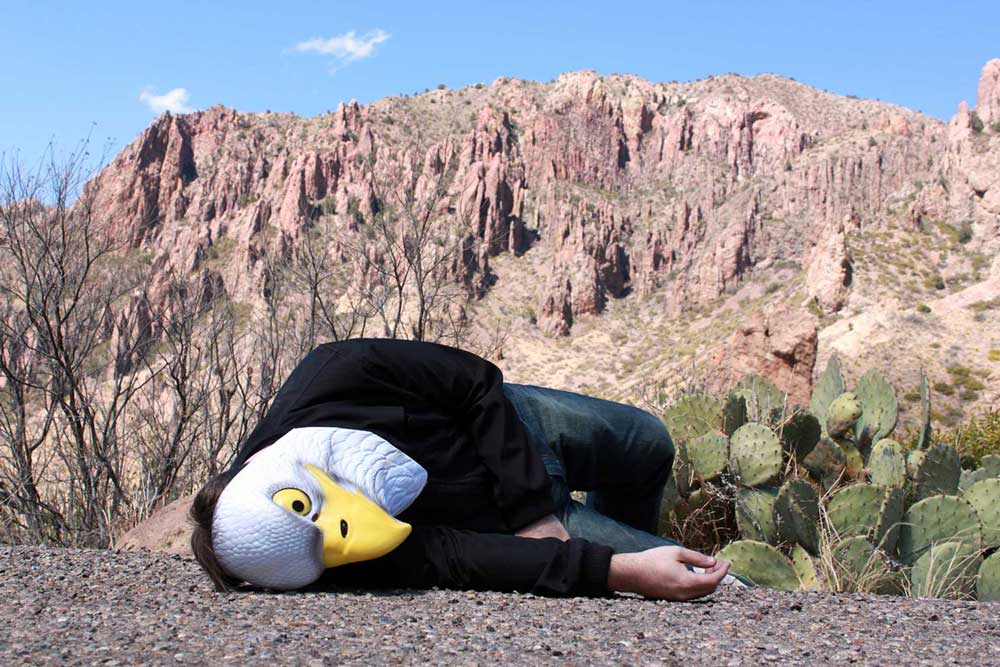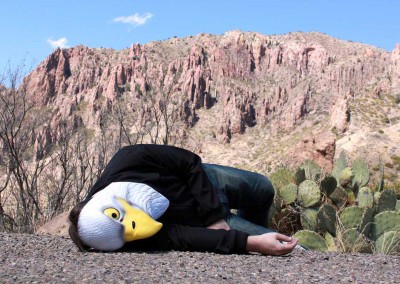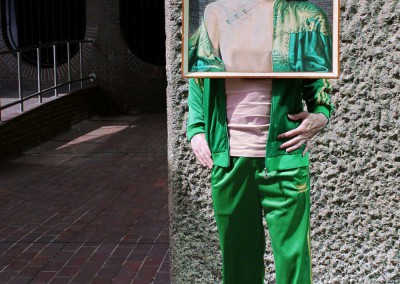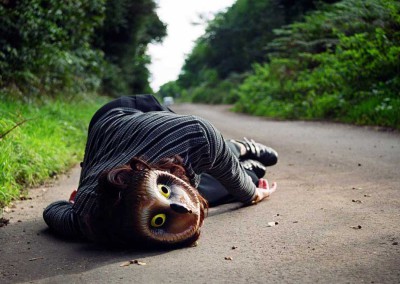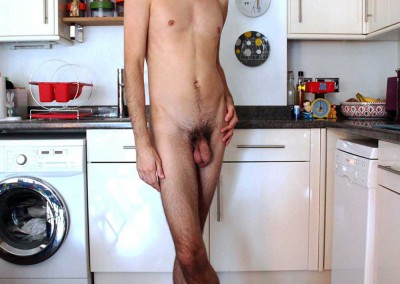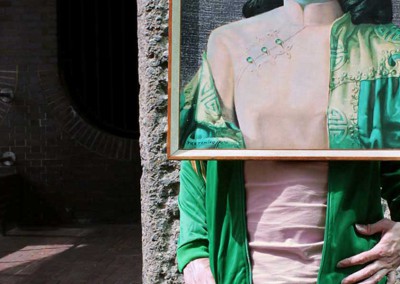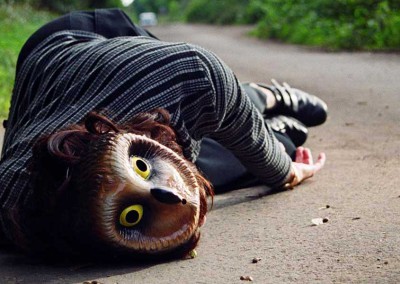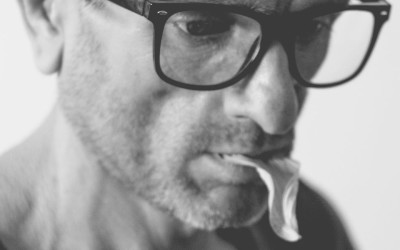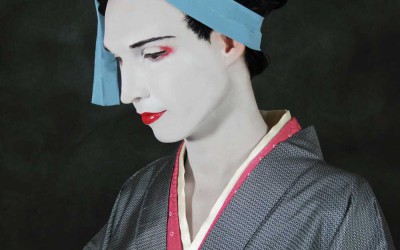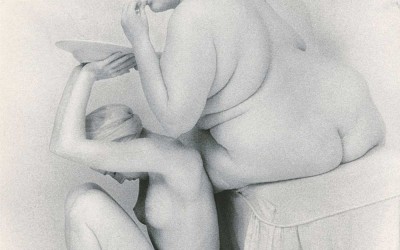Nigel Grimmer
Text JF. Pierets Photos Nigel Grimmer
Quirky and theatrical, is how I described Nigel Grimmer’s work the first time I encountered it; tense and layered upon further inspection. Grimmer’s art practice is an ongoing investigation exploring the relationship between public and personal imagery, focusing on the language of the family album and blurring the line between fine art and snapshot photography.
You are a teacher, a photographer and, I know you as, a visual artist. How do you define yourself?
Definitely as an artist and not a photographer: I use different mediums like sculpting, printing and working with found objects. And when I use photography I definitely use it as a means to an end. The most important thing for me is getting a good picture; I don’t care much about the lens or the technical stuff. Saying this out loud sounds a bit odd, since I teach photography; but it’s important my students create their own concepts and aren’t just the technicians for the ideas of others.
Your work focuses on the language of the family album. Why?
Looking at the family album was the starting point for my art practice. I was thinking about why some people could not, or would not be able to be in the album. How could something simply meant as being documentation cause an anxiety to conform?
Do explain.
When I began my degree I wanted to work about something I knew, so I could speak with some kind of authority. I was very young, had only just left home, so decided to work with our family snapshots. I went home and looked in the album my mother made and kept in a drawer. I discovered that I’d disappeared from our album in high school, that I was no longer being recorded. I wasn’t conforming to the traditional snapshot language. My mother was stuck; where were the next images – me with a girlfriend, me with a baby, me getting married?
That’s quite heavy.
My mother wasn’t leaving me out intentionally; just no material was being produced for her that conformed to the conventions of the album. She was stuck, she had this idea of a life for me and it was hard to adjust. My parents are very supportive of me; they even model for all my projects. They are probably waiting for me to bring a bloke home… A gay teaching colleague told me when she came out she was systematically edited from a relative’s album and that is very different. The relative put stickers over her face. I think it’s visually really funny, editing somebody out with glittery stickers of rainbows and unicorns, that album must be the campest thing ever! But the systematic removal no doubt was emotionally crippling at the time.
How does this translate into your work?
I create pictures of my friends and family members through the continual reworking of the family album format. When you have your family picture taken, people often say: ‘act naturally!’ But what does mean? So in my series, for example Roadkill, I like to focus on this fakeness. The photographs have been taken at traditional snapshot moments such as holidays with friends and family; I wanted to see how long it would take for someone to actually ask to be in one of my crazy family photos, instead of a traditional snapshot. My mother actually took the first photo in the series with me modeling, as I needed an example to show other people what to do. I never thought my father would be in the project, but I told him on the phone that the best selling picture was one of my mother. As we finished the conversation he said: ‘think how many you’ll sell if I’m in the picture’. He understood I wasn’t going to do anything else except be an artist so he just stepped in. In Roadkill he’s a frog, but still not as popular as my mother the owl though.
‘In the first project I used the doll to fill in the gaps in my family album. For example I did not have a graduation ceremony, nor did I get married. I used the doll to act out those things for photographs.’
Part of your work is based on a doll that resembles you. There are two projects with this doll: ‘Nigel Doll’ and ‘Nigelacra’.
In the first project I used the doll to fill in the gaps in my family album. For example I did not have a graduation ceremony, nor did I get married. I used the doll to act out those things for photographs. For Nigelacra I wanted to move away from the physical family album and think about how social media now records our lives. The project features guys wearing a mask based on the doll; it’s my first nude project. It was also the first project I did with people I did not know; the models were recruited from dating apps. The profile I had on the dating app was just an advert to ask if people wanted to be in this project. I wanted to see if I could turn myself into an Internet meme. It took me almost fifteen years to get thirty Roadkill photographs, and four years for someone to ask to be in one of them without any prompt. But it took only a few months to get thirty Nigelacra and guys were asking to be in the photos, which they’d seen on Facebook or various apps, after a week.
But tell me, how that does this work? You go to the house of people you don’t know and they take their clothes off?
Well, yes, actually. I offered them a print or an invite to the exhibition, but mostly they just wanted to be a part of the project. Like being part of the ice bucket challenge. Sometimes they asked me to photograph something else as a swap. Somebody asked to shoot their passport picture, somebody else asked for a head shot, another one asked for a fashion shoot. Some of them wanted better pictures for the dating site or wanted to get into porn…I met people from all walks of life; some had crazy jobs, it was very diverse. There were beekeepers, poets, fashion designers, museum curators and even an actual porn star.
To stay with the topic of masks, your latest project ‘Art Drag Album’ shows you using reproductions of exotic paintings by artists such as J.H Lynch and Vladimir Tretchikoff as disguises. What can you tell me about the series?
For Art Drag Album I introduced a secondary picture plane within the photographic frame. The kitsch vintage paintings were used to create ‘windows’ within the frame causing slippage between the illusionary foreground and background of the photograph. This highlighted the flatness, and so the artificiality, of the photograph. Much of the history of photography is based on a male quest for an exotic other, and these kitsch portraits of strangely hued women reference this ‘otherness’. But I’m changing these exotic beauties into something jarringly common; now they walk the street in sportswear or pyjamas, they’ve been assimilated.
Future plans?
One of Art Drag Album is about to be turned into a giant photo mural for the Olympic Park in London! I’m currently working on the first extensive book of my photo projects called Anti-Portrait. I’ve done quite well this year selling work, so am trying to find an agent or gallery representation so I can spend more time on the projects. I’m going to turn Nigelacra into an app. And I’m always looking for models for all my projects if anyone wants to join in! You can contribute images to any of Nigel’s projects, to be displayed on the I could have done that page of his website.
Related articles
Roxanne Bauwens
Her website states: ‘So far I have done research on various topics: identity, beauty ideals, (ab) normality, medical abnormalities, skin, perception, genderbending and uniqueness in contrast to uniformity.’ Needless to say we were very…..
A Kind of Absence
German photographer and visual artist Dirk H. Wilms focuses on self-portraits since 2001, the year he received his HIV diagnosis. After the diagnosis he barely left his house for almost four years. He thought everyone would know immediately he carried the…..
Matthijs Holland
What do historic figures like Hatshepsut, Pope Joan, Segawa Kikunojo III, Henry III of France and Charlotte von Mahlsdorf have in common? Visual artist Matthijs Holland told us all about it. Do tell! I wanted to create a photo project based on…..
Heavy in White
Lynn Bianchi is a New York City-based fine art photographer and multi-media artist who has shown work in over thirty solo exhibitions and in museums worldwide. Her photographic art has been featured in over forty publications. Bianchi’s Heavy…..
Paul Buijs
Young, reckless and fresh from the Arnhem art academy. In order to find a suitable subject for his graduation project, Paul Buijs went where no other student would follow; the shady underworld of gay darkrooms and sex parties. Hovering…..
